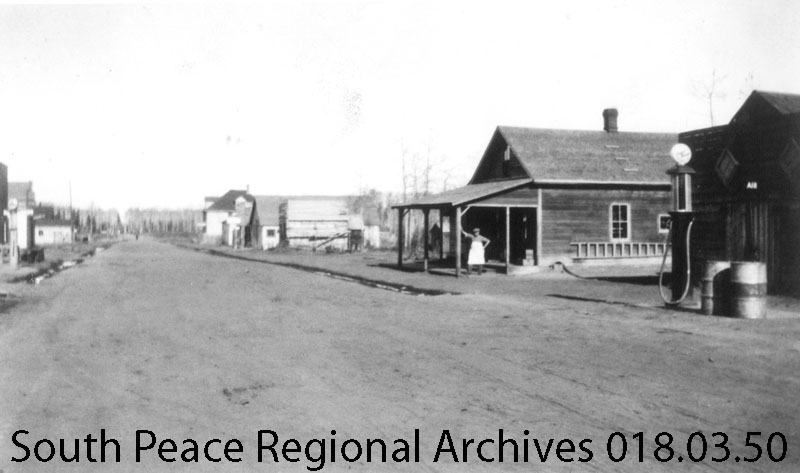Image: Wanham’s Main Street in 1931 (SPRA 018.03.50)
The following excerpt was taken from the diary of Maria Wozniak. Maria’s diary was originally written in Polish, and has been translated and transcribed by her son Mathew. Here she writes about the Wanham-Codesa fire of October 22, 1942.
My husband is in much pain. The next night he can’t sleep because of the pain in his leg. October 22, 1942, the owner of the sawmill was driving to the mill in the bush and stopped in to visit us. It was as if the Lord sent him. Seeing him, I asked Mr. James Emerson if he could take Antoni to a doctor. He looked at the leg and said that in Tangent, there was a government nurse and he would take Antoni to her. In a while, we both took Antoni by the arms and led him to the half ton automobile.
Before harvest, my husband built a small pigpen from round trees about 16 x 16 feet and the threshing machine blew straw over it. In the pen was a door about 4 x 4 feet. Inside the pen was spread straw and so prepared a place for our sows and other animals for the winter. 1942 was dry and the fall was without rain.
Mr. Emerson took my husband to the east to Tangent about 20 miles and in the west there began to appear clouds of smoke. I stood the sick cow “Masia” on her feet. I dropped her a bundle of hay for her to eat.
Fear overtook me about the fire from which so many times I defended our property. The first thing was to harness the horses to the plow and make a fire guard in the field to the west of our buildings so the fire does not come here. Quickly we achieved this task and were ready to plow. Our Eddy did not go to school that day so I took him to the neighbors to the east, Hrishuks, asking them to watch over our son. Fortunately, at the time I was plowing the fire guard, Bill Sanoski came over and took over the plowing. The wind came up about noon and then came approaching danger. While Bill plowed I went with fast steps to where there was a low place where water gathered in the spring, by that place we had dug a well and got some water. Then I went to the barn and chased the cow and calf out. From the west the fire is coming closer. Already we can see the leaping flames. I ran around like a lunatic, I have very little chance of saving anything.
I take out of the house anything I can carry to the garden. Then came frightening wind like it was a storm. Mr. Sanoski is doing everything he can and keeps plowing. The fire jumped over in a few places and the whole field is burning. All the pigs are running to their pen where there is much straw. I poured full their troughs with feed that was farther away from the pens. The hogs went to eat because they were hungry. Soon they were ready to return to their pens. I had armed myself with a good stick and stood in the doorway, our two dogs helped me. I know for sure that the straw pile is on fire from the flying sparks. Everywhere there was fire and smoke and it’s hard to breathe.
Smoke is hurting my lungs and I am tired. I go to the garden and kneel looking at the burning buildings and granaries with grain in them. The view is frightening and the wind goes like crazy. Seeing the fire, people from the district gathered and began to save our neighbour. They stood in a row, both men and women with wet sacks began to extinguish the fire against the wind and in that way saved our neighbours’ buildings. With digging and plowing they were able to save them all. This was the neighbour where our son was staying at.
My husband and Mr. Emerson returned and did not recognize the place. The fire had taken our harvested crop. Somehow our new unfinished house was saved. On that memorable night we sat at our neighbours, Mr. Paupst’s place. Here, too, the neighbours helped save the buildings. People that were built to the west of our place, like Tom Bergeron Bouchard, Soquet, Fred Lewis, Wojenski, and Scott and many others, not only lost their buildings but lost livestock.
At 5:00 in the evening, the police came to see if anyone had lost their lives and how bad were the losses. We lost practically no animals. There were 110 hogs and the cattle were in the pasture where there was not enough grass for the fire to go. In the evening rain began to fall and the ground was covered with snow in the morning of the 23 of October.
A note from Maria’s son, Mathew Wozniak:
The fire started some place in Wanham and a matter of a few hours went about 10 miles. Daughter Cecelia was with Bill plowing the fire guard. She said that they were in an open field and flames singed the horses’ manes. In those days, bundles were hauled in to be threshed so there was very little to burn, just the stubble. The granaries that were full of grain burned and the grain spilled into a cone and kept smoldering. It was important to keep the livestock from getting to these grain piles. A gallon of grain eaten by an animal that had been on grass would most likely kill it. All land clearing at that time was done with axe, saw, and grub hoe, piled and burned so fires getting away were a common problem.
This article was originally featured in the March 2019 issue of Telling Our Stories.
